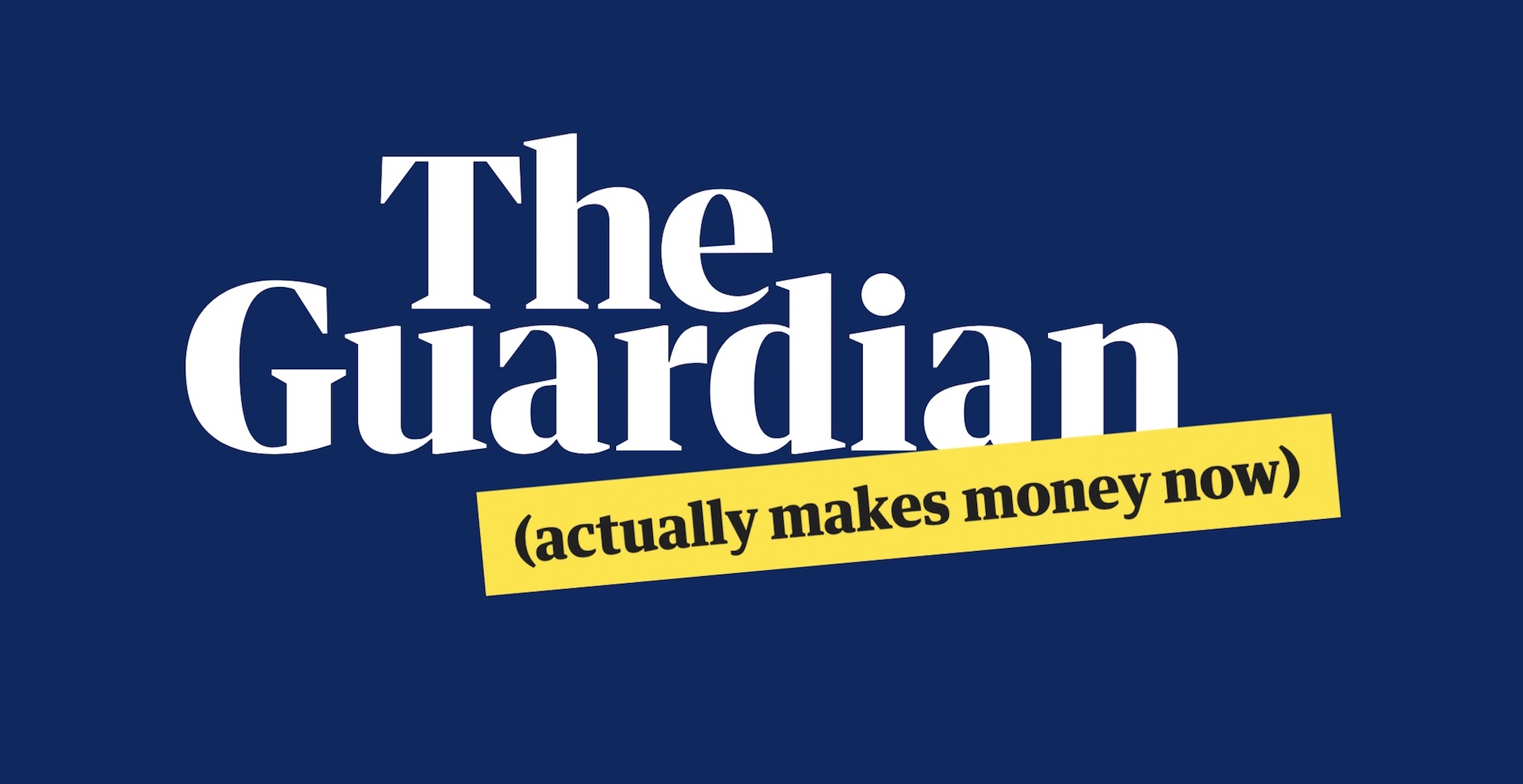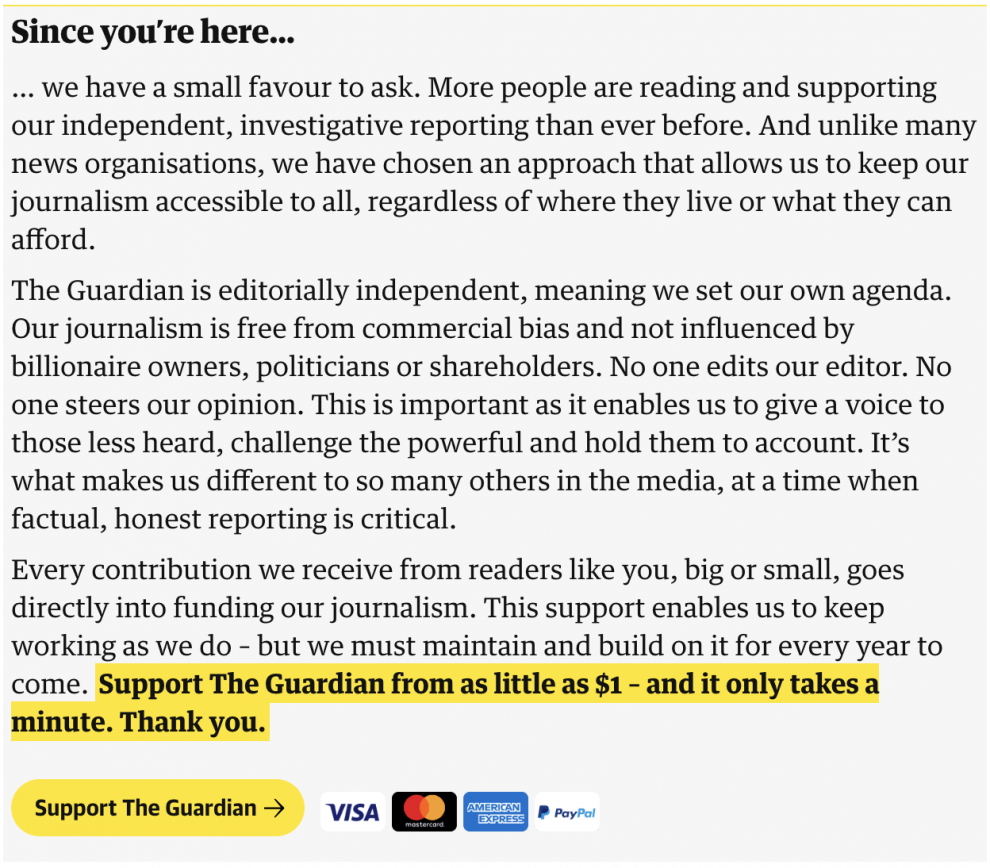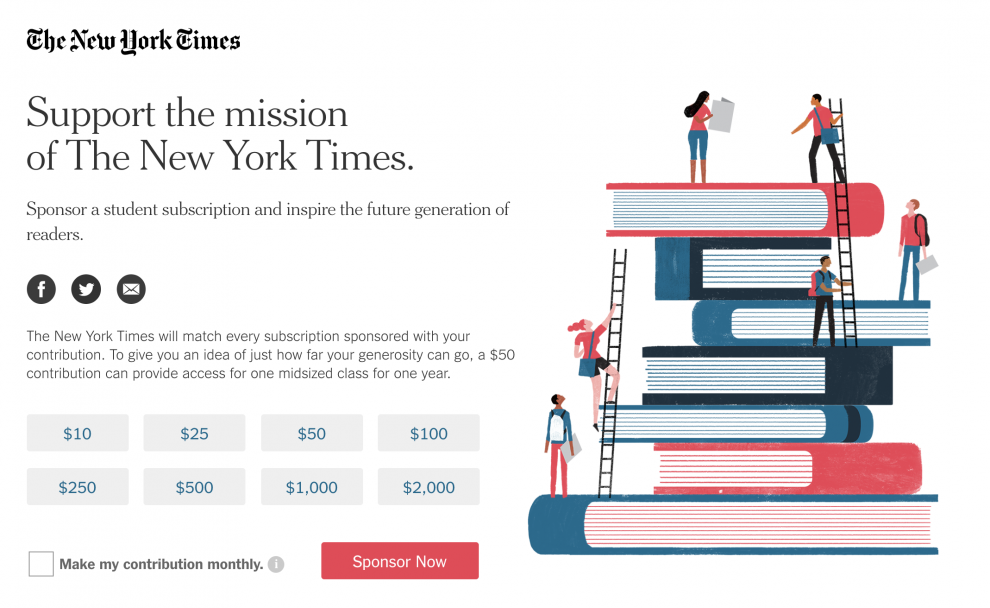
The Guardian is a weird newspaper.
Most newspapers don’t have nearly two-thirds of their readers coming from outside the country they’re based in.
Most newspapers don’t start in one city and then move to another one.
Most newspapers aren’t owned by a trust that mandates they promote “liberal journalism both in Britain and elsewhere.”
And most newspapers don’t lose money year after year after year. Sure, some papers are run by rich men more interested in influence than profit, and some families have chosen to rank civic duty above the bottom line. But in the main, when revenues decline at a newspaper, costs get cut — cut to the point that whatever profit level the owner seeks gets met. Most newspapers that consistently lose money die.
And yet The Guardian is, here again, an especially noteworthy exception. It’s the sort of institution of which Wikipedia can note “The Guardian has been consistently loss-making” and there’s not even a [citation needed]. The BBC calls it “a culture in which constant, vast losses of the kind most private sector companies would not and could not tolerate had become culturally accepted.” (Perhaps a tinge of meanness from the state-funded broadcaster there?) Whether it was other media holdings within the same group or unrelated investments by the Scott Trust, The Guardian has long relied on someone else’s profits to bring it to break-even.
Until now! The Guardian announced this morning that, in its most recently concluded fiscal year, it…made money? “For the first time in recent history”?
Guardian News & Media recorded an £800,000 operating profit for the 2018-19 financial year — compared with a £57m loss three years previously — ensuring the business is existing on a sustainable basis following the culmination of a turnaround programme put in place following years of substantial losses.
(Perhaps it took running a series titled “Broken Capitalism” for The Guardian to get its finances in order.)
More detailed numbers about the paper’s first operating profit since 1998 are here, and here’s editor-in-chief Katherine Viner taking a well-deserved victory lap:
Today, we have announced that the Guardian has successfully completed its three-year turnaround strategy — we have hit our goal of breaking even, and made a small operating profit on our path to sustainability. This means that the money we make from advertisers combined with what we receive in the generous support from you, our readers, has this year covered the cost of producing the journalism that informs and inspires millions of people around the world. Our unique ownership model means we are not controlled by a billionaire owner, or a group of shareholders demanding financial returns — any profits made, and all financial contributions from readers, are reinvested directly into our journalism.
The Guardian has made a small operating profit! It's been a brilliant team effort and it's mostly thanks to Guardian readers — we are out of danger and the new business model is working https://t.co/Ru0bHXs4rj
— Katharine Viner (@KathViner) May 1, 2019
Just in time for Brexit too! (Sorry.)
We’ve been writing here for a long time about the difficult transition newspapers are making (or not making) to digital. If you had to define a few key financial landmarks papers need to hit along the way, you might pick these three taken from Ken Doctor pieces early this decade:
Each of these would be the sort of accomplishment that justifies an officewide party, and The Guardian can now say it’s hit all three — only a few years removed from a seven-year stretch where it lost £227 million, or well over $300 million in Yankee bucks.
Guardian digital traffic is rising; monthly pageviews are up 70 percent since 2016, some of which is I’m sure the result of the twin shocks of Trump and Brexit. (The Trump Bump and the Brexit…Jump? Pump?) But publishers know well that audience doesn’t always translate to revenue.
Today, 55 percent of Guardian revenue comes from digital sources, a real feat of transition. It’s a bar very few major newspapers have met; the Financial Times is the only one that comes to mind. (The New York Times is getting close, with more than 40 percent of its revenue coming from digital, and it’ll probably hit the majority mark next year.) The Guardian saw growth in both digital advertising and digital subscriptions, a combo many papers have missed recently.Perhaps the most amazing number of all: Only 8 percent of Guardian revenue now comes from print advertising — which for literal centuries was the bedrock of the newspaper business model.
Becoming majority digital means you can think of print the way you probably should in 2019: a high-end product, still appealing to a very loyal set of subscribers, that is fundamentally a reshaping of digital output — not the other way around. There’s still money in print, but it can’t be your guiding light anymore.
Speaking of subscriptions! The other papers in The Guardian’s weight class — The New York Times, The Washington Post, The Wall Street Journal, the Financial Times, The Times of London — have all built their revenue strategies around selling digital subscriptions. Their content is valuable, the argument goes, and their readers have money — put up a paywall and watch the money roll in.
That’s been a very good strategy for those papers (less so for smaller ones), but The Guardian has always had a complication: It doesn’t want a paywall. That Scott Trust mission to spread liberalism far and wide doesn’t work as well if your content isn’t accessible to the huddled masses. The New York Times makes a certain amount of sense as an elite, mass-luxury product; The Guardian doesn’t. (That’s despite the fact that New York Times and Guardian readers are fairly interchangeable in a lot of ways.)
So without a paywall, The Guardian has bet on voluntary payments, a membership strategy. And it’s worked! It’s a two-pronged strategy:
Make a digital subscription product for your superfans to buy. The Guardian’s mobile apps are free for all to use. But there’s a (relatively minor in features) upgrade available called Premium — no ads, better offline reading, daily crosswords, some interface differences — that’s available for $6.99 a month. I’d wager that many of the people who buy that subscription are doing so at least as much to support the general mission of The Guardian as to get some crossword puzzles. The Guardian’s now sold 190,000 of these premium subscriptions.
Ask for money, often. If you’ve read a Guardian article on the web, you’ve probably seen a box like this underneath the story’s kicker:

If you’re finally guilted into clicking, the default option you’re shown is a repeating monthly contribution. (For me at least, it suggests $15 a month, $180 a year. You can get a New York Times or Washington Post digital subscription for less than that.) But you also have the option to switch to a one-time gift. In the past year, more than 300,000 people gave one-off contributions — but more importantly, 365,000 are now on an automatic recurring plan.
The repeating revenue is obviously critical to a company that, you know, keeps making new journalism every day, but the one-off contributions are a nice twist on reader revenue that most other newspapers can’t offer. Think about it: If you just think The Washington Post is swell and you want to support their work, how can you just give it $50 other than buying a subscription?
The New York Times is one of the few other newspapers that have figured this out. It lets you “sponsor a student subscription” to the Times to “inspire the future generation of readers.” That’s a heart-tugging pitch for a certain kind of monied Times reader, and it lets the Times do things like say “you should give us $2,000 now” with a straight face.

Of course, giving a digital subscription to a kid costs the Times exactly $0. (Heck, it’s lead generation for eventual paying readers!) But they’ve gotten 30,000 readers to sponsor more than 3 million student subscriptions — which generates something in the neighborhood $10 million for the Times. Just for asking, really.
That may seem a comically straightforward target for a business, but it’s been impossible for most newspaper companies over the past decade. It’s been all about cutting to profit, not growing to profit. (To take one example from the United States: The McClatchy chain generated $2.26 billion in revenue in 2007. Last year, with mostly the same newspapers, that was down to $807 million.)
But annual revenues are now going up at The Guardian: up 3 percent year over year, to be precise, at £227 million.
The overall financial picture of The Guardian has improved in largest part by cutting costs, which are down 20 percent over the past three years. That, unfortunately, has meant eliminating jobs for journalists on multiple occasions. But that 3 percent increase in revenue is an extremely welcome sign that growth may be the path forward, not just endless layoffs and buyouts.
Remember: The Guardian is a weird newspaper. Not all of its strategies could be easily replicated elsewhere. Most newspapers don’t regularly produce much news of interest outside its immediate area, much less around the globe. The Guardian’s strong identification with a point of view makes it easier for readers to feel a connection to their work than it would for a traditional metro daily. And hey, I think we can all agree it’s nice to have a billion-dollar trust fund.
But there are some lessons I think can inform useful strategies elsewhere.